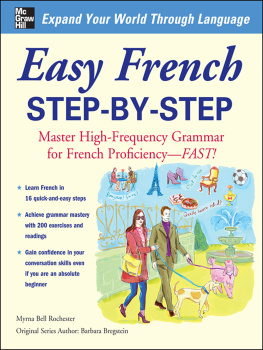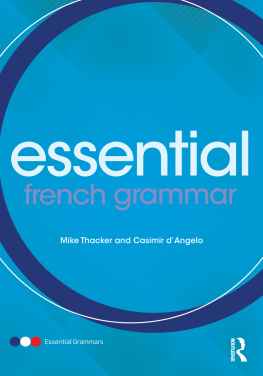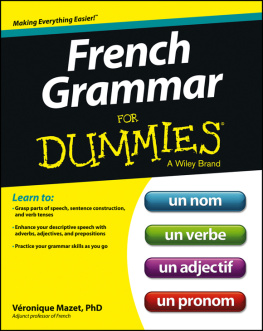Copyright 2009 by McGraw-Hill Education. All rights reserved. Except as permitted under the United States Copyright Act of 1976, no part of this publication may be reproduced or distributed in any form or by any means, or stored in a database or retrieval system, without the prior written permission of the publisher.
ISBN: 978-0-07-164221-7
MHID: 0-07-164221-8
Library of Congress Control Number: 2008928672
The material in this eBook also appears in the print version of this title: ISBN 978-0-07-145387-5, MHID 0-07-145387-3.
E-book conversion by codeMantra
Version 2.0
All trademarks are trademarks of their respective owners. Rather than put a trademark symbol after every occurrence of a trademarked name, we use names in an editorial fashion only, and to the benefit of the trademark owner, with no intention of infringement of the trademark. Where such designations appear in this book, they have been printed with initial caps.
McGraw-Hill Education products are available at special quantity discounts to use as premiums and sales promotions or for use in corporate training programs. To contact a representative, please visit the Contact Us pages at www.mhprofessional.com.
TERMS OF USE
This is a copyrighted work and McGraw-Hill Education and its licensors reserve all rights in and to the work. Use of this work is subject to these terms. Except as permitted under the Copyright Act of 1976 and the right to store and retrieve one copy of the work, you may not decompile, disassemble, reverse engineer, reproduce, modify, create derivative works based upon, transmit, distribute, disseminate, sell, publish or sublicense the work or any part of it without McGraw-Hill Educations prior consent. You may use the work for your own noncommercial and personal use; any other use of the work is strictly prohibited. Your right to use the work may be terminated if you fail to comply with these terms.
THE WORK IS PROVIDED AS IS. McGRAW-HILL EDUCATION AND ITS LICENSORS MAKE NO GUARANTEES OR WARRANTIES AS TO THE ACCURACY, ADEQUACY OR COMPLETENESS OF OR RESULTS TO BE OBTAINED FROM USING THE WORK, INCLUDING ANY INFORMATION THAT CAN BE ACCESSED THROUGH THE WORK VIA HYPERLINK OR OTHERWISE, AND EXPRESSLY DISCLAIM ANY WARRANTY, EXPRESS OR IMPLIED, INCLUDING BUT NOT LIMITED TO IMPLIED WARRANTIES OF MERCHANTABILITY OR FITNESS FOR A PARTICULAR PURPOSE. McGraw-Hill Education and its licensors do not warrant or guarantee that the functions contained in the work will meet your requirements or that its operation will be uninterrupted or error free. Neither McGraw-Hill Education nor its licensors shall be liable to you or anyone else for any inaccuracy, error or omission, regardless of cause, in the work or for any damages resulting therefrom. McGraw-Hill Education has no responsibility for the content of any information accessed through the work. Under no circumstances shall McGraw-Hill Education and/or its licensors be liable for any indirect, incidental, special, punitive, consequential or similar damages that result from the use of or inability to use the work, even if any of them has been advised of the possibility of such damages. This limitation of liability shall apply to any claim or cause whatsoever whether such claim or cause arises in contract, tort or otherwise.
Contents
Preface
Easy French Step-by-Step will help you learn the basics of Frenchfor speaking, reading, and writingas quickly and as thoroughly as possible. Prepared for beginners and advanced beginners, this book teaches French grammar and natural, everyday speech in logical order to enable you to develop and build on your language skills.
To take full advantage of the grammatical progression of this book, youll need to learn each chapter or stepand the sequence within each chapterone after another. We advise you not to skip around. Each step you take will lead you to the next. Chapters consist of clear grammar explanations, numerous reinforcement activities (with a complete Answer Key), vocabulary study, and short practice readings in French. Try to learn every concept before you undertake the next one.
present the fundamentals of verb conjugation and verb use in the present tense (to express declarative statements, negation, yes/no questions, and information questions). We start with the most common French verbs, tre (to be) and avoir (to have), and the largest group of verbs (those with infinitives ending in -er). Complete model verb conjugations allow you to practice all the forms as you learn their meanings. Chapters 4 through 9 present the rest of the regular and irregular verb system, step-by-step, alongside other topics. Vocabulary was selected based on frequency and thematic usefulness. The vocabulary lists will help expand your communicative skills and allow you to function in various settings.
A variety of exercises and activities follow each grammar step and vocabulary list. You may use them to check your understanding and progress. There is a complete Answer Key in the back of the book, which also includes sample answers to all personalized questions. We suggest that you also keep a journal or diary, jotting down your own vocabulary lists, questions, and statements so you can practice them aloud. If you take control of your own learning, youll never be bored!
Original, author-written readings are included in every chapter (starting in ). They become more challenging in form and content as the book progresses. Use these Reading Comprehension sections to learn additional vocabulary (a list of new words follows each reading), to practice reading aloud, and to gain confidence in reading other materials. Try to answer the follow-up questions in complete sentences.
Easy French Step-by-Step is divided into three parts. The first part gives you the elements of French, using the present tense. Youll notice that the word order of English and French is essentially the same. This makes learning in the early stages very quick. The second part explains the use of object nouns and pronouns, pronominal (or reflexive) verbs, the present participle (equivalent to the English -ing), and the imperative (or command form). You will find some of these structures different from English in syntax (word order). The third part of Easy French Step-by-Step expands your competence into the past and future tenses, and the conditional and subjunctive moods, with usage specific to French.
English speakers often say that French is easy enough to readthere are an extraordinary number of cognate (similar) words in the two languagesbut that it is difficult to pronounce. French does have several sounds that do not exist in English; youll need to learn those. Most French sounds, however, both consonants and vowels, are quite similar to English. Be sure to use the upcoming Guide to Pronunciation section for study, review, and reference. Return to it whenever you wish to check something. Practice the sounds and examples out loud. If possible, try to practice with a native or near-native French speaker. Throughout the book, remember to read all the French examples and activities aloud to help develop your pronunciation.
Once you have some experience with the sounds and the letter combinations, you will see that they are limited and consistent, which, believe it or not, will make French easy for you to understand and to spell. If you can spell in English, which is notoriously difficult, you will be able to pronounce and spell in French. Supplement your study by listening to French radio and online broadcasts, CDs, movies, videos, and television programs. With modern media, these opportunities are increasingly easy to come by.










